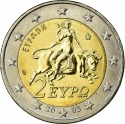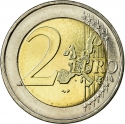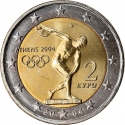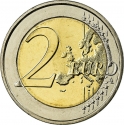You are about to finish your registration. Please check your mailbox (including spam folder). There should be a letter with a confirmation link. Check setting to make sure that your e-mail address is correct.
Send letter againDescription
Spyridon "Spyros" Louis (1873–1940) was a Greek water-carrier who won the first modern-day Olympic marathon at the 1896 Summer Olympics, thereby becoming a national hero.
In Marathon, Colonel Papadiamantopoulos gave the starting signal for the small field, consisting of thirteen athletes from Greece and four from other nations. The early leader of the race, which led over dusty dirt roads along which throngs of Greeks had gathered to watch, was the Frenchman Albin Lermusiaux, who had earlier placed third in the 1500 metres. In the town of Pikermi, Louis made a stop at a local inn to drink a glass of wine. After asking for the advantage of the other runners, he confidently declared he would overtake them all before the end.
After 32 km, Lermusiaux was exhausted and abandoned the race. The lead was taken over by Edwin Flack, an Australian who won the 800 and 1500 m races. Louis slowly closed in on Flack. The Australian, not used to running long distances, collapsed a few kilometers onwards, giving Louis the lead.
In the stadium, the atmosphere was tense, especially after a cyclist brought the news that the Australian was in the lead. But another messenger was sent out by the police as soon as Louis moved into the lead, and as the word spread that it was a Greek that led the race, the cry "Hellene, Hellene!" was taken up by thousands of rapturous spectators. When Louis finally arrived in a stadium erupting with joy, two Greek princes – Crown Prince Constantine and Prince George – rushed to meet him and accompanied him on his final lap for a finishing time of 2:58:50.
Obverse

|
Depicts Spyros Louis and the cup that he was awarded, against the background with the Panathenaic Stadium. Inscribed along the inner edge is the country of issuance HELLENIC REPUBLIC and "75 YEARS IN MEMORIAM OF SPYROS LOUIS". Above the cup appears the year of issuance and to the right the mintmark (stylized acanthus leaf, Athens). The monogram of the engraver below (ΣΤΑΜ, Georgios Stamatopoulos). ΕΛΛΗΝΙΚΗ ΔΗΜΟΚΡΑΤΙΑ |
|---|---|
Reverse

|
A geographical map of Western Europe spans the outer ring and inner core on the right side of the coin. The inscription 2 EURO is superimposed over the map of Europe, with the numeral “2” located in an open field representing the eastern Atlantic Ocean. 2 EURO |
| Edge |
HELLENIC REPUBLIC in Greek ΕΛΛΗΝΙΚΗ ΔΗΜΟΚΡΑΤΙΑ ★ |
Swap now (1 offer)
Characteristics
| Type | Commemorative Issue (Circulating) |
| Material | Bi-Metallic |
| Ring | Cupronickel |
| Center | Nickel Brass |
| Weight | 8.5 g |
| Diameter | 25.75 mm |
| Thickness | 2.2 mm |
| Shape |
|
| Alignment | Medal |
| Mint |
Bank of Greece
|







